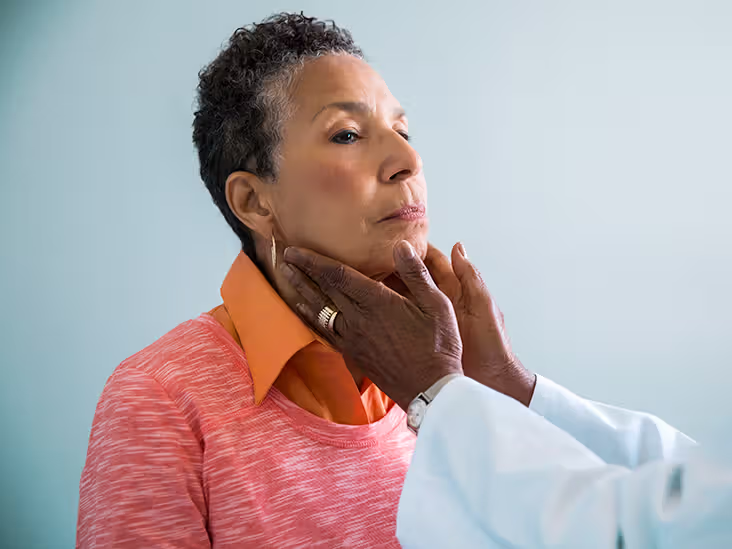Lymph nodes, particularly those in the neck, play a critical role in our body’s immune system. They act as small, powerful defenders, filtering harmful substances like bacteria and viruses from the lymphatic fluid. However, neck lymph nodes can sometimes become enlarged, which may raise concerns about underlying issues, including cancer. In this article, we’ll explore the causes, symptoms, and when to worry about swollen neck lymph nodes.

Understanding Neck Lymph Nodes and Their Importance
Neck lymph nodes, also known as cervical lymph nodes, are part of the lymphatic system. This system runs throughout the body, helping to maintain fluid balance, absorb dietary fats, and support the immune system. Lymph nodes, which are generally pea-sized, are concentrated in areas like the neck, armpits, and groin.
The primary function of these nodes is to filter out harmful substances. When the body detects a threat, such as bacteria, viruses, or even cancer cells, the lymph nodes become active, capturing and processing these foreign invaders. This process often results in temporary swelling, known as lymphadenopathy. But how do you distinguish between a benign swollen lymph node and one that may indicate a more serious issue?
Where Are Neck Lymph Nodes Located?
The neck is home to a network of lymph nodes, grouped in chains. You can find them in various areas:
- Under the Jaw: Submandibular nodes often swell in response to infections in the mouth and throat.
- In Front of the Ears: Preauricular nodes may enlarge due to infections in the scalp or face.
- Back of the Neck: Posterior cervical nodes respond to scalp and skin infections.
- Near the Collarbone: Supraclavicular nodes may indicate an infection in the chest or abdomen when swollen.
Knowing the location of these nodes can help you identify potential issues more effectively, as different infections can affect specific node chains.
What Causes Swelling in Neck Lymph Nodes?
There are several common causes for swollen neck lymph nodes, most of which are harmless and temporary:
1. Infections
- Viral Infections: Illnesses like colds, flu, and mononucleosis are common triggers. In such cases, the lymph nodes may be tender and sensitive to touch.
- Bacterial Infections: Conditions such as strep throat, ear infections, and tonsillitis can lead to enlarged neck lymph nodes.
- Other Illnesses: More serious infections, including tuberculosis and certain sexually transmitted infections, can also cause lymph node swelling.
2. Autoimmune Conditions
- Diseases like lupus and rheumatoid arthritis can trigger lymphadenopathy, as the immune system mistakenly attacks healthy cells.
3. Cancerous Causes
- Lymphoma: A type of cancer that originates in the lymphatic system.
- Metastatic Cancer: Cancer from other parts of the body, such as the breasts or lungs, can spread to the lymph nodes in the neck.
- Head and Neck Cancers: Tumors in areas like the mouth, throat, or thyroid may cause nearby lymph nodes to swell.

Recognizing a Cancerous Lymph Node in the Neck
Most swollen lymph nodes are not cancerous. However, there are some signs that may warrant further investigation:
1. Size and Growth
- A lymph node that continues to grow larger than 1.5 centimeters in diameter, especially without any signs of infection, may need medical evaluation.
2. Hard Texture
- While normal, reactive lymph nodes are usually soft, a cancerous lymph node often feels hard, immobile, and rubbery to the touch.

3. Lack of Pain
- Painful lymph nodes often indicate an infection. Painless, firm lymph nodes are more concerning, as this could be a sign of a malignancy.
4. Persistence Beyond a Few Weeks
- Most swollen lymph nodes due to infections will subside within two to four weeks. Nodes that remain enlarged or continue to grow for more than a month should be assessed by a healthcare provider.
When to Consult a Doctor
Not every swollen lymph node is a cause for alarm. However, consider seeking medical advice if:
- The swelling is accompanied by unexplained weight loss, night sweats, or persistent fever.
- The node remains swollen and hard for more than four weeks.
- You notice multiple enlarged lymph nodes in different areas.
- There is no apparent reason for the swelling, such as a recent cold or flu.
A doctor can diagnose the cause of an enlarged lymph node through a physical examination and potentially recommend tests like blood work, imaging, or a biopsy if cancer is suspected.
Diagnosing and Treating Swollen Neck Lymph Nodes
To identify the cause of lymphadenopathy, a doctor will conduct a thorough examination, which may include:
1. Physical Examination
- The doctor will feel the lymph nodes, checking for size, tenderness, and texture.
2. Imaging Tests
- Ultrasound, CT scans, or MRIs can help visualize the lymph nodes more clearly and assess any abnormalities.
3. Biopsy
- In some cases, a biopsy may be required to rule out cancer. This involves removing a small sample of the lymph node for laboratory analysis.

Treatment for swollen lymph nodes depends on the underlying cause:
- Infections: Antibiotics are effective for bacterial infections, while antivirals may be used for specific viral infections.
- Autoimmune Diseases: Medications that suppress the immune system may be prescribed to reduce inflammation.
- Cancer: Treatment options like chemotherapy, radiation, or surgery may be necessary, depending on the type and stage of cancer.
Understanding the Difference Between a Cyst and a Lymph Node
Sometimes, a cyst can be mistaken for a lymph node. A cyst is a fluid-filled sac that can appear under the skin, whereas a lymph node is part of the lymphatic system. A cyst is typically smooth, movable, and may fluctuate in size, while an enlarged lymph node is firmer and usually stays the same size unless the underlying cause changes.
Conclusion
While swollen neck lymph nodes are usually harmless and a sign of an active immune response, it’s essential to recognize the signs that could indicate a more serious condition. Remember, it’s always better to err on the side of caution. If a lymph node is unusually large, hard, or persistent, consulting with a healthcare provider is a wise decision. By staying informed about your body and understanding when to seek help, you’re taking a proactive step in safeguarding your health.


